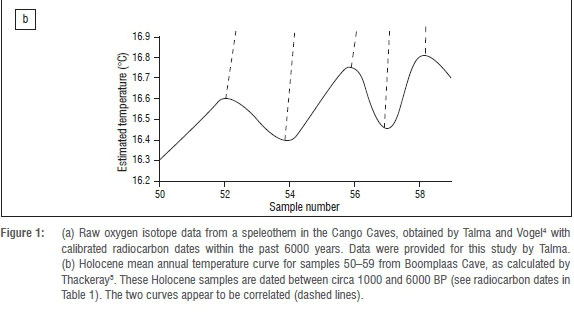Servicios Personalizados
Articulo
Indicadores
Links relacionados
-
 Citado por Google
Citado por Google -
 Similares en Google
Similares en Google
Compartir
South African Journal of Science
versión On-line ISSN 1996-7489
versión impresa ISSN 0038-2353
S. Afr. j. sci. vol.112 no.5-6 Pretoria may./jun. 2016
http://dx.doi.org/10.17159/sajs.2016/a0156
SCIENTIFIC CORRESPONDENCE
Comparison of Holocene temperature data (Boomplaas Cave) and oxygen isotope data (Cango Caves)
J. Francis Thackeray
Evolutionary Studies Institute, School of Geosciences, University of the Witwatersrand, Johannesburg, South Africa
Keywords: Quaternary; palaeoclimate; South Africa
Boomplaas Cave is situated near the town of Oudtshoorn in the Western Cape Province, South Africa. It was excavated by Hilary Deacon1 in the 1970s, yielding not only Late Quaternary artefacts that were of archaeological importance but also fossils of rodents and insectivores (analysed by Margaret Avery2) as well as bovids and equids (analysed by Richard Klein3) that were important for the reconstruction of palaeoenvironments in the context of changes in climate within part of the Late Pleistocene (12 000-80 000 years BP) and Holocene (younger than 12 000 years BP). Also of palaeoclimatic importance is a stalagmite from the adjacent Cango Caves, analysed by John Vogel and Siep Talma. In 1992, Talma and Vogel4 used a transfer function to estimate Holocene temperatures from oxygen isotope data from the Cango speleothem. Their basic oxygen isotope data (Figure 1) can be compared to temperature estimates obtained from Thackeray's5 multivariate analysis of fossil rodents and insectivores represented in the late Quaternary sequence from Boomplaas Cave (Table 1). Here, for the first time, a comparison is made between the results obtained by Talma and Vogel4 with those obtained by Thackeray5, both of which relate to temperature but use independent sources of data.

The oxygen isotope values for the Cango stalagmite are shown in Figure 1a. These values can be compared to the relative changes in Thackeray's temperature estimates for the Boomplaas sequence (Figure 1b). The implication is that there is remarkably good agreement between the raw oxygen isotope data from the speleothem4, and the calibrated temperature curve for the Boomplaas Holocene sequence, based on Thackeray's5 multivariate analysis of fossil rodents and insectivores.
It would appear that the raw oxygen isotope data reflect variation in mean annual temperature, without using a complicated transfer function of the kind employed by Talma and Vogel4.
Using data from the correlations indicated in Figure 1, the following regression equation can be obtained for a relationship between mean annual temperature (MAT) and oxygen isotope ratio (OIR):
MAT = -0.557 OIR +13.55
(r = 0.93)
These results are potentially relevant to interpretations of oxygen isotope ratios from other speleothems, at least for part of the Quaternary in regions adjacent to Boomplaas Cave and the Cango Caves.
Acknowledgements
I am grateful to Siep Talma for access to the tabulated oxygen isotope data for the Cango stalagmite. I thank Jennifer Fitchett for assistance with Figure 1. Margaret Avery identified the rodents and insectivores from excavations at Boomplaas, directed by Hilary Deacon. The correlations presented are the result of ongoing research on palaeoclimates and faunal analyses, supported by grants awarded to J.F. Thackeray from the National Research Foundation (South Africa) and the A.W. Mellon Foundation.
References
1. Deacon HJ. Two Late Pleistocene-Holocene archaeological depositories from the southern Cape, South Africa. S Afr Archaeol Bull. 1995;50:121-131. http://dx.doi.org/10.2307/3889061 [ Links ]
2. Avery DM. Micromammals as palaeoenvironmental indicators and an interpretation of the Late Quaternary in the Southern Cape Province, South Africa. Ann S Afr Mus. 1982;85:183-374. [ Links ]
3. Klein RG. Environmental and ecological implications of large mammals from Upper Pleistocene and Holocene sites in southern Africa. Ann S Afr Mus. 1980;81:223-283. [ Links ]
4. Talma AS, Vogel JC. Late Quaternary paleotemperatures derived from a speleothem from Cango Caves, Cape Province, South Africa. Quaternary Res. 1992;37:203-213. http://dx.doi.org/10.1016/0033-5894(92)90082-T [ Links ]
5. Thackeray JF. Late Quaternary environmental changes inferred from small mammalian fauna, southern Africa. Climatic Change. 1997;10:285-305. http://dx.doi.org/10.1007/BF00143907 [ Links ]
 Correspondence:
Correspondence:
Francis Thackeray
Evolutionary Studies Institute, School of Geosciences, University of the Witwatersrand
Private Bag 3, Wits 2050
South Africa
Email: Francis.thackeray@wits.ac.za
















